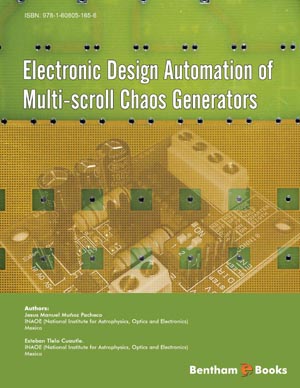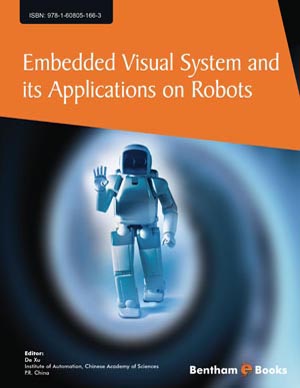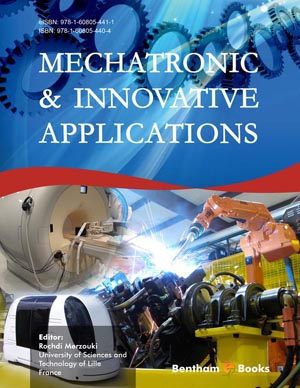Preface
Page: ii-ii (1)
Author: Evelio J. González, Leopoldo Acosta and Alberto F. Hamilton
DOI: 10.2174/9781608051267112010100ii
List of Contributors
Page: iii-iv (2)
Author: Evelio J. González, Leopoldo Acosta and Alberto F. Hamilton
DOI: 10.2174/978160805126711201010iii
Intelligent PID DC Motor Speed Control Alteration Parameters Using Particle Swarm Optimization
Page: 3-14 (12)
Author: Boumediène Allaoua
DOI: 10.2174/978160805126711201010003
PDF Price: $15
Abstract
In this paper, an intelligent controller of DC Motor drive is designed using Particle Swarm Optimization (PSO) method for formation of optimal Proportional-Integral-Derivative (PID) controller alteration parameters. The proposed approach has superior feature, including easy implementation, stable convergence characteristics and very good computational performances efficiency. The DC Motor Scheduling PID-PSO controller is modeled in MATLAB environment. Comparing with fuzzy logic controller using PSO intelligent algorithms, the planned method is more proficient in improving the speed loop response stability, the steady state error is reduced, the rising time is made suitable and the disturbances do not affect the performances of driving motor with no overtaking.
Systems Theoretic Techniques for Modeling, Control and Decision Support in Complex Dynamic Systems
Page: 15-72 (58)
Author: Armen Bagdasaryan
DOI: 10.2174/978160805126711201010015
PDF Price: $15
Abstract
Nowadays, modern complex systems of any interdisciplinary nature can hardly be analyzed and/or modeled without comprehensive usage of system theoretic approach. The complexity and uncertainty of the nature of modern systems, and the heterogeneity of related information, require a complex approach for their study, based on systems theory and systems analysis and consisting of information and expert knowledge management, initial pre-processing, modeling, simulation, and decision making support. As the complexity of systems increases, system theoretic methods become more crucial. Often they provide the only effective tools of obtaining the information about the elements in a system, connections between those elements, and the means for getting the adequate representation of system in a whole. The variety of complex systems can be described by deterministic or stochastic differential equations, statistical mechanics equations, neural network models, cellular automata, finite state machines, multi-agent systems, etc. Most of the complex real world objects are modeled as dynamic systems enriched by artificial intelligence resources. Equipped with artificial intelligence techniques, these models offer a wide variety of advantages such as coping with incomplete information and uncertainty, predicting system’s behavior, reasoning on qualitative level, knowledge representation and modeling, where computer simulations and information systems play an important and active role, and facilitate the process of decision making.
This chapter aims to discuss the problems of modeling, control, and decision support in complex dynamic systems from a general system theoretic point of view, with special emphasis on methodological aspects. We consider the main characteristics of complex systems and of system approach to complex system study. Then the chapter continues with the general dynamic modeling and simulation technique for complex hierarchical systems functioning in control loop. The proposed technique is based on the information-mathematical models and described in terms of the hierarchical state transition diagrams. The methodology is sufficiently abstract to allow both qualitative and quantitative analysis of system state dynamics and control through hierarchical scenario calculus. The evaluation of different scenarios is defined by the multiple criteria vector-functions related to the efficiency of control strategies and time required for system goals achievement. We also offer general architectural and structural models of computer information system intended for simulation and decision support in complex systems.
Fuzzy Controllers Design for the Inertia Wheel Inverted Pendulum
Page: 73-91 (19)
Author: Fatah Chetouane
DOI: 10.2174/978160805126711201010073
PDF Price: $15
Abstract
The purpose of this chapter is to introduce the control problem of a complex system called the Inertia Wheel Inverted Pendulum (IWIP) using fuzzy logic technique. In this study, the IWIP is controlled using three different fuzzy controller designs: a self-tuning fuzzy Proportional-Integral-Derivative controller, a Mamdani-type fuzzy logic controller, and a Sugeno-type fuzzy logic controller. The performance of the designed controllers in regard to achieving stable control of the IWIP is compared and discussed. The main objective of this chapter is to address fuzzy logic controller design efficiently in a simple manner without prior knowledge of fuzzy sets theory. The only mathematics used is to describe the IWIP nonlinear physical model. Fuzzy Logic Controllers (FLC) design is explained based on the intuitive and experimental functioning of the IWIP system. The IWIP is simulated under different fuzzy control methods using Simulink™ fuzzy logic toolbox, Mathworks Inc. The IWIP parameters are provided, and our hope is that this study will serve as a benchmark for graduate students and engineers interested in applying fuzzy logic techniques in their project.
Engineering Congestion Control of Internet Video Streaming with Fuzzy Logic
Page: 92-107 (16)
Author: Martin Fleury, Emanuel A. Jammeh and Mohammed Ghanbari
DOI: 10.2174/978160805126711201010092
PDF Price: $15
Abstract
Congestion control of video streaming over the Internet is necessary, as access to these telecommunications networks is unregulated. A commercial IPTV service in this environment faces unacceptable quality degradation, if the video stream does not respond to the presence of other competing traffic flows. As a solution, fuzzy logic control offers real-time performance, comparatively simple models, fairness to other traffic, and a smooth response. This Chapter introduces the control problem faced in designing a fuzzy logic congestion controller in terms of the restrictions of a compressed video bitstream and the uncertainties that affect congestion control. The Chapter outlines the design of a congestion controller that relies on network packet delay and delay trend as inputs. The controller has been extensively tested and favorably compared to the standard congestion controller. Multimedia applications over telecommunications networks are a promising area to apply computational intelligence.
Artificial Intelligence and Electrical Drives
Page: 108-134 (27)
Author: Ben Hamed Mouna and Sbita Lassaâd
DOI: 10.2174/978160805126711201010108
PDF Price: $15
Abstract
The main topic of this chapter is the application of artificial intelligence as fuzzy logic and neural network in motor drive systems. Artificial Neural Network (ANN) speed sensorless fuzzy control both in scalar and vector control of induction motor are presented and analyzed. The feasibility and effectiveness of the proposed methods are verified through experimentation. The experimental is built all around dSpace system with DS1104 controller board based on digital processor (DSP) TMS320C31.
Mobile Manipulator with Resolved Acceleration and Knowledge-Based Fuzzy Active Force Control
Page: 135-158 (24)
Author: M. Mailah, E. Pitowarno and A. Noshadi
DOI: 10.2174/978160805126711201010135
PDF Price: $15
Abstract
Perfect motion control of a mobile robotic system combining both the kinematic and dynamic aspects is still regarded as a challenging and complex problem to deal with. The proposed research study is aimed towards realizing the solution through the application of a novel and robust intelligent Active Force Control (AFC) based strategy to control a differentially-driven wheeled Mobile Manipulator (MM) system with nonholonomic constraint. The scheme incorporates an intelligent mechanism using a Knowledge-Based Fuzzy (KBF) algorithm to compute the essential estimated parameter in the AFC loop to trigger the compensation effect. A set of knowledge is investigated based on a priori knowledge with respect to a hypothesis that there exists a close relationship between the signal patterns of the generated tracking error with the actual velocity and the estimated inertial parameters of the MM system. The feasibility of implementing a Resolved Acceleration Control (RAC) technique as a kinematic-based feedback controller for the MM is first explored. The system is further consolidated with the inclusion of an intelligent AFC with KBF element that is directly embedded in cascaded form with the RAC part, serving as a dynamic-based scheme for the enhancement of the overall control scheme. The robustness of the proposed AFC-based scheme is rigorously tested with the application of the introduced disturbances in the form of constant braking torques, impact and vibratory excitations. The robust and accurate trajectory tracking performance of the system is particularly highlighted in the study to illustrate the practical viability of the proposed scheme.
Intelligent Systems Used in Continuous Casting Process
Page: 159-179 (21)
Author: Gelu Ovidiu Tirian
DOI: 10.2174/978160805126711201010159
PDF Price: $15
Abstract
This first chapter of this paper work refers to Simulink implementation of a neural and fuzzy system of crack prediction, detection, and rejection during the continuous casting processes. The neural and fuzzy system is made up by a neural network used for fissure detection and a fuzzy controller for predicting and rejecting them. This system uses a signal received from the neural network and some data to correct the casting speed and the primary cooling water. The second part of chapter describes the industrial Fuzzy System Decision (FSD) deployment of crack prediction and elimination as well as the adaptive system meant for eliminating any sliding between the semi-finished and the roll drawings (SFA), when the FSD casting speed performs any corrections. The last part of chapter describes an adaptive fuzzy system to eliminate any sliding that may occur between the billets and roll drawings in steel continuous casting plants. Any sliding may compromise the tuning speed of hardware caused by prediction system and crack elimination – therefore, speed corrections are common and applied as a necessary step. Design and production systems are based on an original research of the author.
A Novel Electric Load Demand Forecaster Using Taguchi’s Method and Artificial Neural Network
Page: 180-192 (13)
Author: Albert W.L. Yao, J.H. Sun, H.T. Liao, C.Y. Liu and C.T. Yin
DOI: 10.2174/978160805126711201010180
PDF Price: $15
Abstract
The use of Artificial Neural Network (ANN) for electric load forecasting has been proposed in many studies. Among these studies, the daily peak load or total load with weather consideration was mostly predicted in order to dispatch high-quality electricity or assess electric load efficiently for power utilities. However, load demand forecasting from the standpoint of consumers is seldom discussed. With the global market competition, enterprises invest in instruments to cut down on large electricity bills of operating costs. A formal study shows that the regular ANN training model was inadequate to deal with volatile load patterns, especially in Very Short-Term Electric Demand Forecasting (VSTEDF). In this paper, we present Taguchi’s and rolling training methods of ANN for VSTEDF. By using this proposed rolling training model, the electric load demand is predicted precisely every 2 minutes. The forecasting error is smaller than 3%. Compared with the conventional ANN model and Grey model, the proposed Taguchi-ANN-based predictor has better accuracy in the application of VSTEDF. The improved Taguchi-ANN-based electricity demand forecaster in conjunction with the PC-based electricity demand-control system is a cost-effective and efficient means to manage the usage of electricity.
An Application of a Dynamic Matrix Control Algorithm: Path Tracking Using Predictive Control
Page: 193-197 (5)
Author: J. Espelosín, A. Hamilton, L. Acosta, J. Toledo and E.J. González
DOI: 10.2174/978160805126711201010193
PDF Price: $15
Abstract
An automatic steering system for a self-guided vehicle must be able to track its course smoothly and accurately. In order to meet this requirement, a predictive controller has been implemented in the Verdino prototype. In this chapter the principles behind this kind of controller, as well as the details of the actual implementation, are presented.
Index
Page: 198-198 (1)
Author: Evelio J. González, Leopoldo Acosta Sánchez and Alberto F. Hamilton Castro
DOI: 10.2174/978160805126711201010198
Introduction
This e-book focuses on the application of artificial intelligence resources in fields related to Control and Automation Engineering. Techniques such as neural networks, fuzzy logic and expert systems are a key tool for researchers and engineers requiring powerful solutions to a wide range of problems. The e-book should be a useful guide for these engineers and presents practical examples of real cases where these techniques have been successfully applied.






